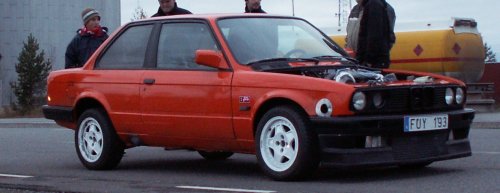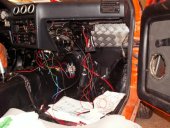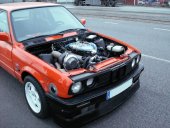BMW E30 323 with M20B25 Turbo

The engine
- Inline 6 cylinder BMW M20B25, 2.5 litres, ignition order 153624.
- Wastefire ignition with Ford EDIS wasted spark coils (stock 60-2 trigger wheel)
- Sequential fuel injection with no cam sensor and low-Z 720 cc/min injectors
- Custom engine harness
The turbo system
- PPF turbo manifold (pulse-split)
- External wastegate 50 mm from Bostr├â┬Âm Turbo Teknik
- 3.5" downpipe and exhaust system out through the (no muffler)
- Dump valve by Simon Marmander
- Custom large intercooler
- Holset HX50 turbo
The config and tables will be updated on this page, and documented properly given some free time. Here they are: [config.txt] and [tables.txt]
Bear in mind that fuel has not been set properly, including afterstart and other enrichments.
Progress
Above 6000 rpm this engine has run into the problem with the ignition dwell. The Ford EDIS coils need 4 ms dwell but that is simply not possible since the current method used in firmware doesn't allow overlapping dwell. At 7000 rpm one revolution of the engine takes 8.57 ms and there are three ignition events. The time between each ignition event is 2.86 ms on a 6 cyl engine, and there is currently 400 us "coil off time" which means an effective 2.46 ms dwell on coils that need 4 ms. There is little point in having 8 ignition drivers with this limitation. We hope this will be resolved by spring 2006 when the car will be on the road again for some serious tuning to get the most power out of the engine.
The engine is running well but we have established that the poor fuseholder that was initially used caused 2 injector drivers to break, they can open if I work them manually (mdh..) (even with appr. 1A load ?) but give no measureable amount of fuel through the injector if used.
- My fear is that the remaining 6 FETs have been affected as well even though we seem to have no problem with the engine at higher load.
- If you can measure the voltage across injectors (preferrably at idle, with DVM in 20V DC mode), that will reveal if the pulsewidths are different. IMHO if FETs are measured to be able to drive 1A load, it's unlikely they will output different pulsewidths because of slow FET-opening or something.
Idle and low load problems with big injectors (short pulsewidth, appr. 1000 usec or lower) are usually caused by different opening characteristics of the injectors (this is possible, even if the injectors are measured to flow exactly the same amount when fully opened). This injector-difference can be suppressed (most often to good result) with raising the flyback voltage. When PWM-ing, take care the current capability is sufficient: see
- BY399 diode and 0.1 Ohm 5W resistor in WebShop
- or the new (PCB expected 2005-10-28, soon in WebShop) mid-voltage (5diode, >14A) flyback board that increases the pulsewidth (and, as a side-effect, the required DC% when PWMing is applied) by adding the voltage drop of 5 diodes (to the 2 onboard diodes: resulting in appr. 7*0.7V=4.9V flyback voltage)
This doesn't explain why the IGBTs show inproper diode voltage, they have internal clamping for the back EMF and of the two IGBTs that measure diode voltage - only 00 was used to drive a coil, 06 was never used. The injector FETs that died probably didn't have flyback of the proper voltage at the instant that the injectors they fired were closing, they had to take the back EMF. The 2 FETs and 2 IGBTs are replaced later this winter.
The main problem we have now is tuning the fuel injector characteristics, these are big 720 cc/min injectors and are very fast. How fast is yet to be determined. As the idle only requires about 0.6-0.7 msec opening time it's critical to get this right. I guess experimentation is the only way to figure this one out.
- Emil used 100 usec opening time and 150 usec rampup on a 4 cyl Volvo with 1000 cc injectos, same brand of injectors. But it does not work well:
- 100 usec opening time is against recommendations, so we will use injopen=0 and very low battfac (100usec or so). injocfuel=900usec (rampup time) can be good for fast injectors, but this really requires some experimentation (usually above 1000usec gives best result).
Some pictures of the car and engine
History
I'm helping a local guy with installing a Genboard on a M20B25 BMW inline 6 cyl engine with Bosch L-jetronic electronics and intake and distributor ignition. The M20B25 originally doesn't come in this configuration (Motronic only) but a previous owner swapped out the block and head of the 323 for 2.5 litre parts and retained the electronics and intake (very stupid, engine ran lean on too small injectors). The stock harness will be cut-up and partly re-used and directly wired to EC connectors - a lesson learned from a previous BMW 728 project with similar electronics, meaning the stock L-jetronic connector and box will not be used.






